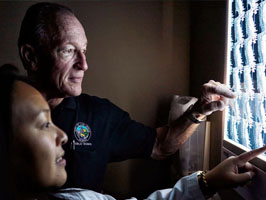Spine surgeons are always seeking new ways to perform spine surgery in a safe, effective way that will make your recovery less painful and more rapid. A technique called minimally invasive lateral lumbar interbody fusion (LLIF) is a relatively new minimally invasive technique designed to achieve these goals.
There are several other names for lateral lumbar interbody fusion, but they all represent the same surgery:
• transpsoas interbody fusion: This technique is called transpsoas because it goes through (trans) your psoas muscle. This muscle—responsible for movement and stability in your hips and low back—runs along the length of your lower spine. It's easy for your surgeon to navigate through it because it's so large.
• direct lateral interbody fusion (DLIF)
• eXtreme lateral interbody fusion (XLIF)
All of these strive for the same thing: to relieve your back pain.
Minimally invasive LLIF is done from your side; lateral means side. That way, there's less damage to your back muscles, ligaments, and blood vessels.
Some spine surgeons prefer this technique over a posterior (back) approach (eg, posterior lumbar interbody fusion)or an anterior (front) approach (anterior lumbar interbody fusion).
When Is Minimally Invasive Lateral Lumbar Interbody Fusion Used?
Your low back is a common source of pain because it carries the largest amount of your body weight. Minimally invasive LLIF can help alleviate your pain by:
• relieving pressure on your spinal cord and/or nerve roots
• stabilizing your spine
This surgery is commonly performed in people who have:
• degenerative disc disease
• herniated disc
• degenerative scoliosis
• low-grade spondylolisthesis
How Minimally Invasive Lateral Lumbar Interbody Fusion Is Done
For this procedure, you'll be lying on your side, and you'll most likely be under general anesthesia.
Your surgeon will use intraoperative imaging, such as fluoroscopy (a special type of x-ray) during your procedure. This helps make your surgery as safe as possible, by helping the surgeon identify all of the key anatomy during your surgery.
Your surgeon will typically make 2 small incisions on your side—one for a special tube (a tubular retractor) through which your entire surgery will be performed and one for a probe, which helps guide your surgeon during your procedure. These incisions are usually less than 5 cm.
The tubular retractor mentioned above is a special tool that helps hold back your muscles and other soft tissues. This tube will be gently pushed through your psoas muscle until it reaches your spine. Then, a series of progressively larger tubes will be inserted, one tube around the other. This will help to slowly open up the area where your surgery will be done.

